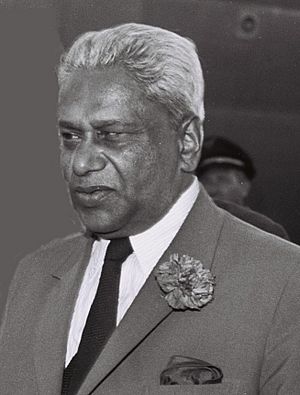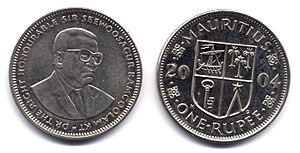Seewoosagur Ramgoolam facts for kids
Quick facts for kids
Seewoosagur Ramgoolam
|
|
|---|---|
| शिवसागर रामगुलाम | |

SSR at Lod airport in 1962
|
|
| Governor-General of Mauritius | |
| In office 28 December 1983 – 15 December 1985 |
|
| Monarch | Elizabeth II |
| Prime Minister | Anerood Jugnauth |
| Preceded by | Dayendranath Burrenchobay |
| Succeeded by | Sir Cassam Moollan (acting) |
| 1st Prime Minister of Mauritius | |
| In office 12 March 1968 – 30 June 1982 |
|
| Monarch | Elizabeth II |
| Governor General | Sir John Shaw Rennie Sir Michel Rivalland (Acting) Sir Leonard Williams Sir Raman Osman Sir Henry Garrioch Sir Dayendranath Burrenchobay |
| Preceded by | Office established |
| Succeeded by | Anerood Jugnauth |
| Chief Minister of Mauritius | |
| In office 26 September 1961 – 12 March 1968 |
|
| Monarch | Elizabeth II |
| Governor | Thomas Douglas Vickers (Acting) Sir John Shaw Rennie |
| Preceded by | Office Established |
| Succeeded by | Office abolished |
| Lord Mayor of Port Louis | |
| In office 1958–1959 |
|
| Preceded by | Edgard Millien |
| Succeeded by | Guy Forget |
| Leader of Labour Party | |
| In office 1 December 1958 – 15 December 1985 |
|
| Preceded by | Emmanuel Anquetil |
| Succeeded by | Sir Satcam Boolell |
| Personal details | |
| Born | 18 September 1900 Belle Rive (now Kewal Nagar), British Mauritius |
| Died | 15 December 1985 (aged 85) Port Louis, Mauritius |
| Resting place | SSR Botanical Garden |
| Citizenship | Mauritian |
| Political party | Labour Party |
| Spouse | Sushil Ramjoorawon (1922–1984) |
| Children | Navin Ramgoolam Sunita |
| Parents | Moheeth Ramgoolam (father) Basmati Ramchurn (mother) |
| Residence | State House (Official) Rue Deforges, Port Louis (personal) |
| Alma mater | University College London London School of Economics |
| Profession | Physician |
| Website | ssr.intnet.mu |
The Rt Hon. Sir Seewoosagur Ramgoolam GCMG LRCP MRCS (often called Chacha Ramgoolam) was a very important Mauritian politician. He was also a statesman and a philanthropist, meaning he cared about helping others. He became the first Chief Minister, then the first Prime Minister of Mauritius, and later the Governor-General of the island. He played a huge role in Mauritius becoming an independent country.
Contents
Early Life and Education
Sir Seewoosagur Ramgoolam, also known as Kewal, was born on September 18, 1900, in Belle Rive, Mauritius. His family was Indo-Mauritian. His father, Moheeth Ramgoolam, came to Mauritius from India as a worker in 1896. He worked as an indentured labourer, which means he worked under a contract, and later became a Sirdar (an overseer) on a sugar estate.
Young Ramgoolam first learned about Bhojpuri language and Indian culture at a local evening school called a Baitka. Here, a teacher (called a guruji) taught children prayers and songs from Hindu scriptures like the Vedas and the Ramayana.
He later went to a Roman Catholic Aided School and then to Bel Air Government School. When he was seven, his father passed away. At twelve, he had an accident that caused him to lose his left eye. He continued his studies at Curepipe Boys’ Government School. While living with his uncle, he often listened to discussions about local politics and India's fight for independence led by Mahatma Gandhi. These talks helped shape his own political ideas.
After finishing secondary school, Ramgoolam worked in the Civil Service for a short time. With help from his brother, he then traveled to London in 1921 to study medicine. He studied at University College London and also attended classes at the London School of Economics.
Family Life
In 1939, Ramgoolam married Sushil Ramjoorawon. They had a daughter named Sunita and a son named Navin Ramgoolam, who also became a Prime Minister of Mauritius later on.
Journey to Independence
Early Political Steps
After finishing his medical studies, Ramgoolam returned to Mauritius in 1935. He wanted to improve the lives of the people on the island, especially the descendants of Indian and African workers. In 1947, he joined the Labour Party, a political group working for social justice.
During the Second World War, in 1940, he helped start the Labour Party's newspaper called Advance. This newspaper pushed for things like universal suffrage (the right for everyone to vote), economic improvements, and fairness for all people. Ramgoolam wrote articles for the paper using the pen name Thumb Mark II, challenging the powerful sugar estate owners.
From 1940 to 1953, he was an elected Municipal Councillor in Port Louis, helping to run the city. He was also elected Deputy Mayor in 1956 and became the Lord Mayor of Port Louis in 1958. He also served in the Legislative Council, which was like a parliament, from 1940 to 1948, and was re-elected several times.
Leading the Way to Freedom
Ramgoolam became the leader of the Mauritian Labour Party in 1959. He played a key role in discussions with Britain about Mauritius's future. At a meeting in London in 1961, some groups wanted Mauritius to stay connected with Britain. However, Britain had already decided to let most of its colonies become independent.
Under British supervision, Ramgoolam served as the Chief Minister and Minister of Finance from 1961 to 1965. He then became Premier from 1965 to 1968. In 1965, he was honored by the Queen and became a Sir.
In 1967, he formed a group called the Independence Party (Mauritius) with other political parties. This group worked together to achieve full independence for Mauritius from Great Britain. After the 1967 general election, Mauritius finally became an independent country in 1968.
After Independence
First Prime Minister
After Mauritius gained independence in 1968, Seewoosagur Ramgoolam became its first Prime Minister. In 1969, he formed an alliance with another political party, the Parti Mauricien Social Démocrate (PMSD), to keep his government strong.
Later Years and Governor-General
His party faced challenges, and in the 1982 elections, the Labour Party lost, and Ramgoolam even lost his own seat in parliament. However, he later helped a new party, the MSM, win the 1983 elections. The Labour Party then joined a coalition government with the MSM.
In 1983, Ramgoolam was appointed as Governor-General, a position he held until his death in 1985. As Governor-General, he represented the Queen in Mauritius. Sir Satcam Boolell took over as the leader of the Labour Party after Ramgoolam.
Ramgoolam also served as the Chairperson of the Organisation of African Unity from 1976 to 1977, showing his importance on the African continent.
His Lasting Legacy
Sir Seewoosagur Ramgoolam is remembered as the "Father of the Nation" in Mauritius. Many places are named after him, including:
- The Sir Seewoosagur Ramgoolam Botanical Garden, a beautiful garden.
- The Sir Seewoosagur Ramgoolam Medical College, a medical school.
- The Sir Seewoosagur Ramgoolam International Airport, the main airport in Mauritius.
- Kewal Nagar, a village previously called Belle Rive, where he was born.
His face is also on every Mauritian Rupee coin and on the highest value banknote, the Rs2,000 note. Monuments have been built to honor him in Mauritius and even in his ancestors' village in India.
See also
 In Spanish: Seewoosagur Ramgoolam para niños
In Spanish: Seewoosagur Ramgoolam para niños


